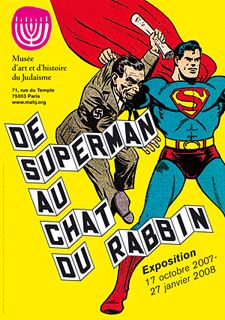 | The Museum of Jewish Art and History in Paris in presenting at this time a new and unique exhibition, the first French show depicting fully the key-role that several artists and writers of Jewish origin played in the world of comic books art, by means of more than 230 works and documents, mainly original drawings, notes, finished and printed pages, sketches. The curators have focused on the Golden Age in comics' history, 1890 - 1930, when this vast industry was practically founded, a time when especially Jewish artists from New York became some of the most important names in this field. New York was for decades the US center for comic books, and Jewish artists were some of the best, their comic strips being published in Yidish and US newspapers, despite often being attacked for their ideas and even their origin. |
The 1930 - 1940's was an important decade in the history of comics, at most of the oldest and best superheroes were "born" at that time : Superman (1938), Batman (1939), Captain America (1940). All of these were American heroes, symbols of the US ideals and later war effort - all of them will be used in Allied and especially in American propaganda - but little is known that they were also inspired by old Jewish legends and ideals. These superheroes and their adventures were also an answer and a defence against the Great Crisis of 1929 and especially the rise of Fascism in Europe. These symbols of justice and good will end up eventually fighting Nazis as well as supervilains in the pages of comic books, all in the name of freedom, democracy and humanity.
The show hosted by the Museum of Jewish Art and History focusing on the works of the most important comics artists, such as Will Eisner, largely present in the show, one of the first in the field, au author of both comic books and graphic novels. He was one of the founders of the Eisner & Iger Studiio, where several of the best artists worked. He published several graphic novels, such as A Contract with God. After the war, several Jewish comics artists became involved in political activities and protests - such as Harvey Kurtzman, founder of the MAD magazine - while others, such as Bernard Krigstein or Al Feldstein used the war and Shoah experience in their works. This idea would be carried on in the 1970s - 1980s by other Jewish artists, who used their own experiences of their families' in their comics and graphic novels, such as Miriam Katin, Bernice Eisenstein, Martin Lemelman.
Also, rather unknown chapters of Jewish history or Jewish myths were used as subjects in comic books, and in Europe this trend was strong. Here one of the best Jewish artists was without a doubt Hugo Pratt (Corto Maltese, Koinsky) who managed to combine his childhood memories and his passion for adventures and Kabbalah in fascinating and popular albums.
In thr 90's the Golem figure was used for the first time in a comics, in Le Silence de Malka, signed by Jorge Zentner and Ruben Pellejero, while in France authors such as Joann Sfar introduced stories from Jewish history and tradition, in works like Le Chat du rabbin.
Photo : mahj.org
2007-11-06

































